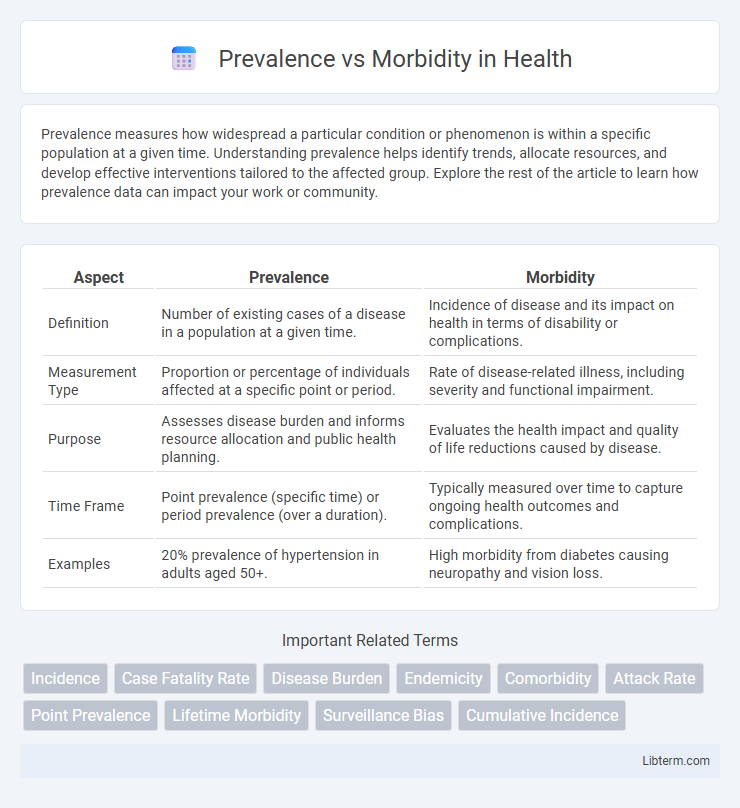Prevalence measures how widespread a particular condition or phenomenon is within a specific population at a given time. Understanding prevalence helps identify trends, allocate resources, and develop effective interventions tailored to the affected group. Explore the rest of the article to learn how prevalence data can impact your work or community.
Table of Comparison
| Aspect | Prevalence | Morbidity |
|---|---|---|
| Definition | Number of existing cases of a disease in a population at a given time. | Incidence of disease and its impact on health in terms of disability or complications. |
| Measurement Type | Proportion or percentage of individuals affected at a specific point or period. | Rate of disease-related illness, including severity and functional impairment. |
| Purpose | Assesses disease burden and informs resource allocation and public health planning. | Evaluates the health impact and quality of life reductions caused by disease. |
| Time Frame | Point prevalence (specific time) or period prevalence (over a duration). | Typically measured over time to capture ongoing health outcomes and complications. |
| Examples | 20% prevalence of hypertension in adults aged 50+. | High morbidity from diabetes causing neuropathy and vision loss. |
Understanding Prevalence and Morbidity
Prevalence measures the total number of existing cases of a disease in a population at a specific time, reflecting the overall disease burden. Morbidity refers to the incidence or rate of new cases and the severity or disability caused by the disease, highlighting its impact on health. Understanding prevalence and morbidity aids in healthcare planning, resource allocation, and evaluating disease control strategies.
Definitions: What is Prevalence?
Prevalence refers to the total number of existing cases of a specific disease or condition in a population at a given point in time or over a specified period. It measures the proportion of individuals affected, encompassing both new and pre-existing cases, providing insight into the overall burden of the disease. Prevalence is crucial for understanding healthcare needs and resource allocation in public health management.
Definitions: What is Morbidity?
Morbidity refers to the presence of disease, illness, or any form of health impairment within an individual or population. It encompasses the rates, severity, and impact of conditions that affect quality of life, distinct from mortality which relates to death. Morbidity data are essential for healthcare planning, resource allocation, and understanding the burden of chronic or acute diseases.
Key Differences Between Prevalence and Morbidity
Prevalence measures the total number of existing cases of a disease in a population at a specific time, reflecting disease burden, while morbidity refers to the incidence or rate of disease occurrence and associated health complications. Prevalence captures both new and ongoing cases, emphasizing how widespread a condition is, whereas morbidity focuses on the impact of illness through symptoms, disability, and duration. Understanding these distinct metrics is crucial for public health planning, resource allocation, and evaluating disease control effectiveness.
Measuring Prevalence: Methods and Examples
Measuring prevalence involves calculating the proportion of individuals in a population who have a specific disease or condition at a given point or period. Common methods include cross-sectional surveys, which collect data at one time, and longitudinal studies that track changes over time, with examples such as using population health surveys to determine diabetes prevalence or electronic health records analysis for chronic disease monitoring. Accurate prevalence measurement informs public health planning by identifying disease burden and guiding resource allocation.
Assessing Morbidity: Tools and Indicators
Assessing morbidity involves using various tools and indicators such as disease incidence rates, hospitalization records, and disability-adjusted life years (DALYs) to measure the burden of illness in a population. Morbidity indicators provide critical data on the frequency, severity, and impact of diseases, enabling health professionals to monitor chronic disease prevalence, acute conditions, and overall population health. Accurate morbidity assessment supports targeted healthcare interventions, resource allocation, and policy development to improve public health outcomes.
Epidemiological Significance of Prevalence
Prevalence measures the proportion of individuals affected by a disease at a specific point or period, reflecting the overall disease burden in a population, while morbidity represents the incidence or rate of new disease cases and the severity of health outcomes. The epidemiological significance of prevalence lies in its ability to inform public health planning, resource allocation, and the evaluation of chronic conditions' impact on communities. High prevalence rates indicate sustained disease transmission or long duration, guiding interventions and healthcare policy priorities.
Clinical Importance of Morbidity
Morbidity measures the presence of disease and its impact on a population's health, providing critical insights into the clinical burden beyond mere disease frequency indicated by prevalence. Tracking morbidity informs healthcare providers about the severity, complications, and functional impairments associated with conditions, guiding clinical decision-making and resource allocation. Understanding morbidity is essential for developing targeted interventions that improve patient outcomes and quality of life.
Implications for Public Health Policy
Prevalence measures the total number of existing disease cases in a population at a specific time, guiding public health policy to allocate resources for widespread chronic conditions. Morbidity refers to the incidence of disease and the severity of health complications, informing policies targeting disease prevention and management efforts. Understanding the distinction between prevalence and morbidity enables policymakers to optimize intervention strategies and improve healthcare outcomes effectively.
Summary: Choosing Prevalence or Morbidity in Health Research
Prevalence measures the proportion of individuals with a specific condition at a given time, offering insights into the burden of disease within a population. Morbidity refers to the incidence or rate of new cases and the severity of disease, essential for understanding health outcomes and healthcare needs. Selecting prevalence or morbidity depends on research goals: prevalence suits cross-sectional studies and resource allocation, while morbidity is optimal for assessing disease risk and progression over time.
Prevalence Infographic

 libterm.com
libterm.com